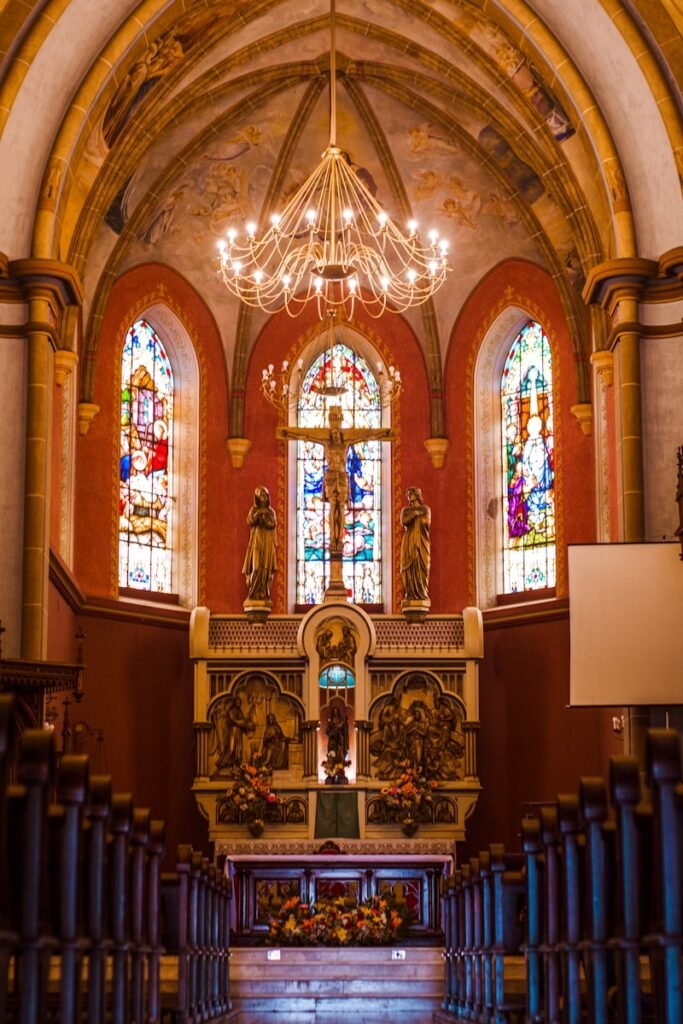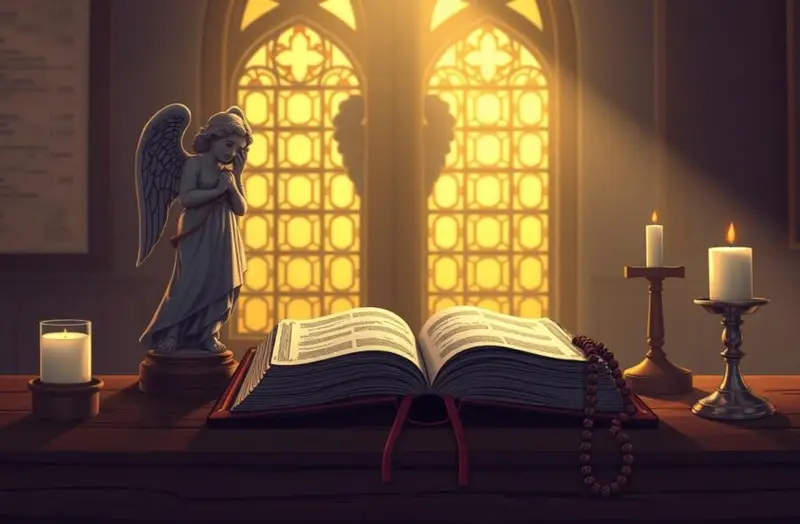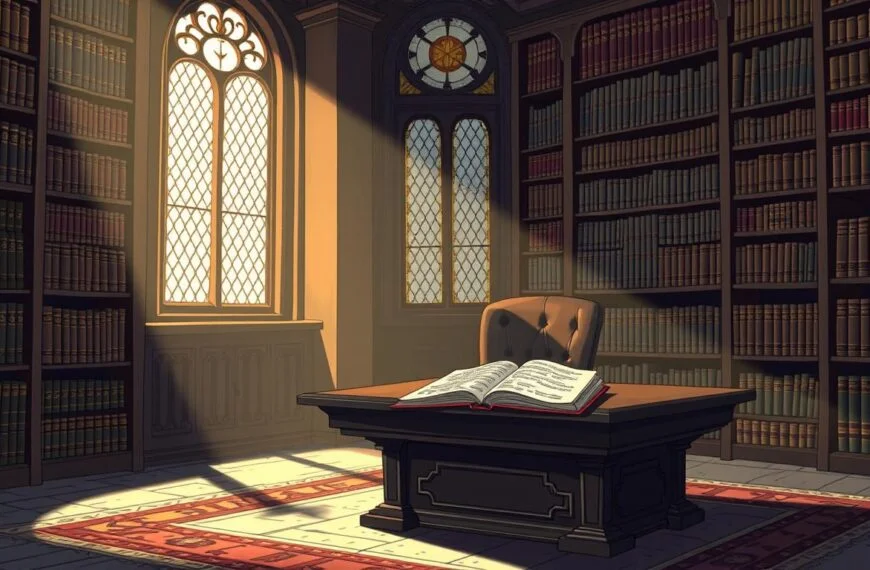When it comes to religion, there are often misconceptions and blurred lines between different denominations and belief systems. One such example is the distinction between Catholicism and Christianity. Many assume that they are synonymous, but the truth is, they are not quite the same. So, what really sets them apart? And are there any similarities that bring them together? Join us as we unravel the mysteries behind these two influential faiths, exploring their core beliefs, rituals, and traditions. Prepare to have your preconceptions challenged as we delve into the similarities and differences between Catholicism and Christianity.
In this article, we will dig deep into both religions, uncovering the core beliefs, worship practices, church hierarchy, devotional traditions, and much more. By examining these aspects, we aim to unravel the intertwining threads between Catholicism and Christianity. So, let us embark on a quest to uncover the striking similarities and uncover the intriguing differences that define these two religions.
Table of Contents
Core Beliefs of Catholicism and Christianity
In understanding the essence of Catholicism and Christianity, it is essential to explore their core beliefs, which have shaped these religions for centuries. Both Catholicism and Christianity share fundamental tenets that revolve around their faith in God, Jesus Christ, and the Holy Trinity.
God: Central to both Catholicism and Christianity is the belief in the existence of one supreme and loving God. Followers of both faiths regard God as the creator of all things and the ultimate source of guidance and salvation.
Jesus Christ: Catholics and Christians alike share a profound belief in the divinity of Jesus Christ. They hold that Jesus is the Son of God, who came to Earth as a human to redeem humanity from sin and offer eternal life through his crucifixion and resurrection. Jesus’s teachings and spiritual leadership are highly revered by both religious communities.
| Catholicism | Christianity |
|---|---|
| Belief in the authority of the Pope, who is seen as the successor of Saint Peter and the head of the Church. | No centralized authority; each individual church or denomination operates autonomously, led by clergy or ordained leaders. |
| Veneration of Mary, the mother of Jesus, as an influential intercessor between humans and God. | While Mary is acknowledged as the mother of Jesus, her role is not exalted to the same level of veneration as in Catholicism. |
| The practice of the sacraments, including baptism, Holy Communion (Eucharist), and confession. | Similar sacraments are practiced, but with variations in their form and significance across different Christian denominations. |
The Holy Trinity: Both Catholicism and Christianity affirm the doctrine of the Holy Trinity, which declares that God exists as three persons: the Father, the Son (Jesus Christ), and the Holy Spirit. This concept underscores the complex relationship between these divine entities and their unified existence.
The Bible: The significance of the Bible as a spiritual guide is paramount in both Catholicism and Christianity. The Bible is regarded as the sacred and authoritative Word of God, serving as the foundation for moral teachings, guidance, and spiritual enlightenment.
While Catholicism and Christianity share fundamental core beliefs, there are notable distinctions in terms of church hierarchy, worship practices, and interpretations of scripture. These variations add richness and diversity to the two religions, as they continue to impact the lives of millions of believers worldwide.
Worship and Sacraments in Catholicism and Christianity
In Catholicism and Christianity, worship is considered a central aspect of religious practice. Both religions place importance on communal worship, prayer, and participation in sacraments. However, there are notable differences in the specific rituals and practices followed.
Sacraments in Catholicism

In Catholicism, the sacraments are seen as sacred rituals that confer spiritual grace on individuals. There are seven sacraments recognized by the Catholic Church:
- Baptism
- Confirmation
- Eucharist
- Reconciliation
- Anointing of the Sick
- Marriage
- Holy Orders
The Eucharist, also known as the Holy Communion, holds particular significance in Catholic worship. It is believed to involve the transformation of bread and wine into the body and blood of Jesus Christ.
Sacraments in Christianity

In Christianity as a whole, sacraments are also observed, although the exact number and interpretation may vary among different denominations. The two sacraments commonly recognized across various Christian traditions are:
- Baptism
- Communion or the Lord’s Supper
Some Christian denominations, such as those in the Protestant tradition, may recognize fewer sacraments or emphasize them differently compared to Catholicism.
Worship Practices
In terms of worship practices, both Catholicism and Christianity involve regular communal gatherings for prayer, worship songs, and the reading of sacred scriptures, primarily the Bible. However, the structure and formality of worship services may vary.
In Catholicism, the Mass is the central act of worship. It follows a well-defined liturgical structure, with specific prayers, readings, and rituals performed by priests and other liturgical ministers. The importance of visual symbols, sacraments, and rituals is emphasized in Catholic worship.
Christian worship services, on the other hand, can vary in style and formality, depending on the denomination. Some may follow a liturgical structure similar to Catholic Mass, while others may adopt a more informal and contemporary approach. The emphasis is often placed on communal singing, preaching, and the celebration of sacraments.
Overall, while both Catholicism and Christianity share common elements in worship and sacraments, there are distinct differences in their practices, traditions, and theological interpretations.
| Catholicism | Christianity |
|---|---|
| Seven sacraments | Varies by denomination |
| Eucharist as the body and blood of Christ | Communion or Lord’s Supper |
| Structured and formal worship | Varies by denomination |
Church Hierarchy and Leadership
In Catholicism and Christianity, the church hierarchy plays a crucial role in maintaining the organizations and guiding the faithful. Understanding the structure of the clergy and the roles of leadership is essential in comprehending the nuances of these religions.
In Catholicism, the church hierarchy is highly organized and centralized, with the Pope at the top as the spiritual leader and head of the Catholic Church. The Pope is considered the successor of Saint Peter and holds the highest authority in matters of doctrine and faith. Beneath the Pope are the bishops, who oversee specific geographical areas called dioceses and are responsible for the spiritual well-being of the faithful within their regions. Working alongside the bishops are the priests, who administer the sacraments and provide pastoral care to the Catholic community.
In Christianity, the church hierarchy varies across different denominations and traditions. While some Protestant denominations have a more decentralized structure, with no single authority figure like the Pope, others may have a hierarchy that is comparable to Catholicism but with different titles and roles. For example, in the Anglican tradition, the Archbishop of Canterbury holds a significant leadership role, similar to the Pope in Catholicism, while in other Protestant denominations, leadership may be shared among pastors, elders, and deacons.
Here is a summary of the key positions in the church hierarchy:
| Catholicism | Christianity (varies) |
|---|---|
| Pope | Varies (no central figure or equivalent) |
| Bishops | Archbishop or regional leaders (Anglican tradition) Pastors, elders, deacons (Other Protestant denominations) |
| Priests | Pastors, ministers, priests |
Roles and Responsibilities
The roles of leadership in both Catholicism and Christianity revolve around guiding the faithful, administering sacraments, and promoting the teachings of the respective religions. Bishops and priests, regardless of the tradition, have a vital role in the pastoral care and spiritual guidance of their communities.
While the exact roles and responsibilities may differ between denominations, the primary focus is on leading by example, imparting religious teachings, and providing support to the worshiping community.
It is important to note that the church hierarchy and leadership are not limited to these positions alone, and there may be variations within different branches and sub-groups of Catholicism and Christianity.
For in-depth information on the roles and responsibilities of the church hierarchy in Catholicism and Christianity, continue reading in Section 6: Devotional Practices and Traditions.
Devotional Practices and Traditions
In Catholicism and Christianity, devotional practices and traditions hold significant importance in nurturing the spiritual lives of believers. These practices create a sense of connection, reverence, and devotion to God, while also fostering community and unity among the faithful.
Prayer
Prayer is a fundamental devotional practice in both Catholicism and Christianity. It is a means of communicating with and seeking guidance, strength, and peace from God. However, the styles and forms of prayer can differ between the two traditions. In Catholicism, forms of prayer include the Rosary, Novenas (nine days of focused prayer), and specific prayers to saints. Christianity emphasizes personal prayer and encourages believers to communicate directly with God.
Religious Holidays
Both Catholicism and Christianity observe religious holidays that hold deep spiritual significance. In Catholicism, key events and seasons, such as Christmas (celebrating the birth of Jesus), Easter (commemorating the crucifixion and resurrection of Jesus), and Lent (a period of reflection and penance before Easter), are observed with special liturgies and traditions. Similarly, Christians celebrate these holidays, although practices and liturgies may vary among different denominations and individual churches.
The Veneration of Saints
An important devotional practice in Catholicism is the veneration of saints. Saints are seen as spiritual guides and intercessors who can pray to God on behalf of believers. Catholics may pray to specific saints, ask for their intercession, and seek their guidance in various aspects of life. In contrast, while Christianity acknowledges the importance of saints, it does not emphasize their veneration in the same way as Catholicism. Christians may view saints as inspirational figures but focus predominantly on a personal relationship with God and Jesus Christ.
Devotional practices and traditions in both Catholicism and Christianity play a crucial role in fostering spirituality, connecting believers to their faith, and guiding their relationships with God.
| Devotional Practices and Traditions | Catholicism | Christianity |
|---|---|---|
| Prayer | Forms of prayer include the Rosary, Novenas, and specific prayers to saints. | Emphasizes personal prayer and direct communication with God. |
| Religious Holidays | Observes Christmas, Easter, and Lent with special liturgies and traditions. | Celebrates the same holidays, but practices may vary among different denominations. |
| The Veneration of Saints | Prays to specific saints, asking for intercession and guidance. | Views saints as inspirational figures but focuses more on a personal relationship with God and Jesus Christ. |
The Role of Mary and the Saints
In Catholicism, the veneration of Mary, the mother of Jesus, holds a significant role. Mary is seen as a model of faith and devotion, revered for her purity and obedience to God’s will. She is considered the Queen of Heaven and is believed to intercede with her son on behalf of believers.
The veneration of saints is also an important aspect of Catholicism. Saints are seen as holy individuals who have lived virtuous lives and are now in the presence of God. They are seen as powerful intercessors and are called upon to pray for the needs of the faithful.
While Mary and the saints hold significant roles in Catholicism, their place within Christianity as a whole may differ. Some Christian denominations, such as Eastern Orthodoxy, also venerate Mary and the saints to varying degrees. However, other branches of Christianity do not place the same emphasis on their veneration.
“The role of Mary and the saints in Catholicism is deeply rooted in tradition and theology. These practices highlight the belief in the communion of saints and the powerful intercession of these holy individuals.”
It is important to note that the veneration of Mary and the saints in Catholicism is often a source of controversy and confusion for those outside the faith. Some may misunderstand or misinterpret these practices as forms of worship, when in reality, they are acts of honor and devotion.
By exploring the role of Mary and the saints in Catholicism, we can gain a deeper understanding of the rich traditions and beliefs that shape this religious tradition.
Key Differences and Similarities Summarized
Throughout this article, we have explored the key differences and similarities between Catholicism and Christianity. While both religions share a foundation in the belief of Jesus Christ as the savior, there are distinct characteristics that set them apart.
One of the significant differences between Catholicism and Christianity lies in the interpretation and authority of religious teachings. Catholicism places importance on the teachings of the Pope and the Magisterium, while Christianity emphasizes the authority of Scripture and the individual’s personal relationship with God.
Another notable difference is the role of Mary and the veneration of saints. Catholicism holds Mary as the Mother of God and venerates saints as intercessors, whereas Christianity, in general, assigns a more modest role to Mary and does not venerate saints in the same manner.
However, despite these differences, there are also several similarities between Catholicism and Christianity. Both religions share a belief in the Holy Trinity – God the Father, God the Son (Jesus Christ), and God the Holy Spirit. They also have a common emphasis on the worship of God and the practice of sacraments, such as baptism and the Eucharist.
FAQ
What is the difference between Catholicism and Christianity?
Catholicism is a subset of Christianity. While Catholicism is a specific denomination within Christianity, Christianity as a whole encompasses various other denominations and beliefs.
What are the core beliefs of Catholicism and Christianity?
Both Catholicism and Christianity share core beliefs in God, Jesus Christ, and the Holy Trinity. They also both hold the Bible as a sacred text.
How do Catholicism and Christianity differ in terms of worship and sacraments?
Catholicism places a strong emphasis on sacraments, such as the Eucharist, baptism, and confirmation, while Christianity as a whole may have varying practices and interpretations of these rituals.
What is the difference in church hierarchy and leadership between Catholicism and Christianity?
Catholicism has a hierarchical structure led by the Pope, bishops, and priests. Christianity, on the other hand, has diverse leadership structures depending on the specific denomination.
What are some devotional practices and traditions unique to Catholicism and Christianity?
Catholicism has distinct devotional practices such as the Rosary, while Christianity as a whole encompasses various traditions such as prayer and religious holidays.
What is the role of Mary and the saints in Catholicism and Christianity?
Catholicism places a significant emphasis on Mary, the mother of Jesus, and the veneration of saints. Christianity as a whole may have varying beliefs and practices regarding the role of Mary and the saints.
Can you summarize the key differences and similarities between Catholicism and Christianity?
Catholicism is a specific denomination within the broader category of Christianity. They share core beliefs in God, Jesus Christ, and the Holy Trinity, but differ in terms of hierarchy, worship practices, and the role of Mary and the saints.

Rockin’ the faith, one verse at a time!
Growing up, the Bible’s stories deeply impacted me. Now, with over 15 years of preaching experience, I blend timeless teachings with modern technology, making them relevant for today’s world.
Bible Hub Verse is my platform to share historical insights and thought-provoking articles, exploring both familiar and uncommon Christian topics. My passion is building a welcoming online space for everyone to learn, grow in their faith, and discover the Bible’s enduring message.
Join the journey!
God bless you.







